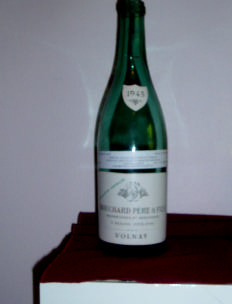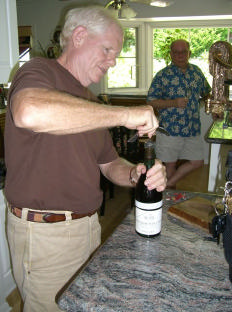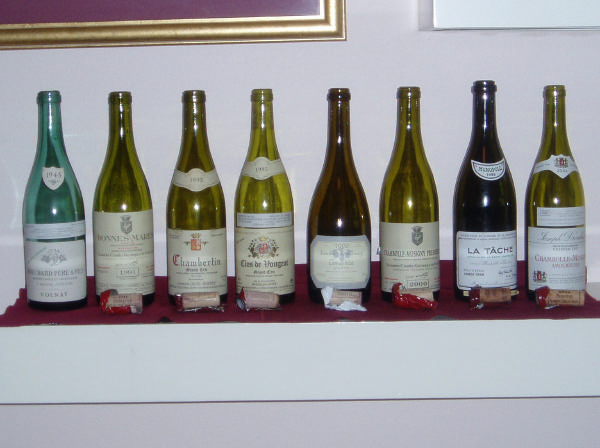When I’m Sixty-Four
Sixty-four is not a major age milestone, but I will take it anyway. Paul McCartney
memorialized aging in his love song, “When I’m Sixty-Four,” written at the tender
age of 16. I gathered up a few wine cronies, most of whom are hovering around my
same age, raided my cellar for some good Burgs and sat down on a Sunday afternoon
to celebrate another year. The well-cellared wines turned out to be vinous
treasures resulting in a very memorable tasting. Here is the lineup with some
commentary. All wines had appropriate fills and there were no corkage issues.


2002 Domaine Drouhin Chambolle Musigny Les Amoureuses 1er
13.0% alc.. This vineyard is one
of a handful that many experts deem worth of grand cru status (and is priced accordingly). It is situated
just below Musigny and is considered the “younger brother to Musigny.”
·
The aromatics are quite
sensual featuring violets, roses, and cassis. The predominately red fruit flavors are buttressed by brisk
acidity. Clean, crisp and thoroughly satisfying, this is truly a complete wine deserving of great admiration.
2000 Domaine Comte Georges de Vogue Chambolle Musigny 1er Cru
14.0% alc.. The Domaine
produces about 4,000 cases a year of five wines: Musigny Blanc, Chambolle Musigny, Chambolle
Musigny 1er Cru, Chambolle Musigny Les Amoureuses 1er Cru, Bonnes-Mares, and Musigny. The
Chambolle Musigny 1er contains grapes from young Musigny vines.
·
The striking aromatics come at
you like a speeding truck and are far and away the most flamboyant in the lineup save the La Tache. Cinnamon
spice, ripe dark cherry and some buttery oak aromas lead to a fat and rich stuffing of mature red
and black fruits. There is some earthiness as well. The texture is all silk. Seduction 101.
1999 Domaine Romanee-Conti Le Tache
11-14% alc., $450. Le Tache is a legendary wine of such great
acclaim that it is hard to do it justice by any descriptive measure (it is said that you discuss a good Bordeaux,
but you simply enjoy a good Burgundy). It is also hard to see beyond the label. La Tache is, of
course, a monopole, like Romanee-Conti.
·
There is bottomless cassis, wild strawberries and Oriental
spice on the nose with dark cherries flashing through the flavors. Rich in the nose and the taste (“stacked
and packed”), yet elegant and refined, it seems perfect in every way. Although a treat to drink now, it is
still a youngster and withholding some hidden charms. Truly, a festive occasion.
1996 Domaine Pierre Damoy Clos de Beze
13.5% alc.. Clos de Beze
lies north of Chambertin, between it and Mazis. Pierre Damoy owns the
largest parcel of the climat by far.
·
The nose is replete with hi-tone dark
cherries, raspberries and baking spice. Rich and concentrated, the wine
displays a copious amount of sweet, sappy fruit which carries to a lengthy
and refreshing finish highlighted by a berry kiss. There is lively acidity to
buttress the fruit.
1995 Haegelen-Jayer Clos Vougeot
Alfred Haegelen married Madeleine, a niece of the
great Henri Jayer. His wines are restrained and long-lasting. Clos Vougeot is the largest (50.59 ha)
grand cru in the Côte-de-Nuits, but the quality of wines from this vineyard vary greatly due to the large
number of owners and the placement of their respective blocks in the vineyard.
·
Quite pleasing with a
charming toast note to the aromas, lively tart cherry flavors, a silky texture, and plenty of length and acidity
on the thoroughly enjoyable finish.
1993 Domaine Denis Mortet Chambertain
13% alc.. Before his tragic death by suicide at the age of
49 in 2006, Mortet was a consummate perfectionist who believed in the meticulous management of his
28 acres of vineyards. His wines were bold and frequently extracted, but when he achieved more refinement,
they were marvelous. I remember a number of years ago, sampling a number of mid-1990s
wines from Mortet and found many heavy-handed. However, I was taken by the Les Champeaux
wines and my experience with these led me to delve more deeply into Burgundy. All of his wines
were made with 100% new French oak.
·
The aromatics were striking (dark spiced cherries, vanillin oak)
and superceded the flavors. The lively acidity was wanting for a food companion. The body of fruit was on
the light side, there was little grip, and the finish was short.
1991 Domaine Comte Georges de Vogue Bonnes-Mares
13.5% alc.. This Domaine can trace its
roots back 550 years and today the 20th generation of the family is in charge. About 420 cases of
Bonnes-Mares are produced each year from the Domaine’s holdings which are in the Chambolle
portion of the vineyard. The vines average 29 years in age. Several critics have written that the Vogue
wines of the 1990s are excellent and in great vintages are truly magnificent examples of fine Burgundy.
·
A lovely nose of ripe cherries with floral accents. Shy flavors of sweet red cherries, spice and a
hint of citrus. Appears to be fading. A good wine, but disappointing considering the pedigree.
1943 Bouchard Pere & Fils Volnay
11-14% alc.. You never open a bottle like this
with high expectations, but it is nevertheless always a thrill when the wine is this
old.
·
The black cork came out cleanly. The wine was a surprise to all. The color was
medium ruby with only a trace of orange tinge at the rim. There was still notable
sweet red fruits on the palate with a little spice and fecundity. The wine was delicate
with cashmere tannins. It was a brief, but memorable fling. because the wine was
spent an hour later.

Wine writer Dan Berger has said, “What the Burgundy lover really seeks is a silky elegance inside the
deep flavors, an experience that is elusive and rare.” I think we found that elegance in several of
these wines. Most had impressive balance, fine tannins, no oak or alcohol intrusion, and with an acidity
that kept them fresh and alive. Beyond that, they displayed an attraction that is defies adequate
description.
Where can you read more and learn about Burgundy? There are a number of excellent internet
sources for information. Burgundy is a maze of vineyards, producers and confusing nomenclature and
the Burg enthusiast must commit serious time and study to be able to purchase wisely and gain an
appreciation for the myriad of wines that come from this small wine-producing region of France. A
first step is to learn the geography and I have included a map of Burgundy on the next page (courtesy
of Berry Bros & Rudd’s wine retailers in the UK - www.bbr.com).

Reference books are few and many are outdated. The two standard texts are Cote D’Or
A Celebration of the Great Wines of Burgundy written by Clive Coates M.W. (1997) and
The Great Domaines of Burgundy authored by Remington Norman (1996). Burgundy and
Its Wines, by Nicholas Faith (2002) is filled with glorious photographs of Burgundy.
More recent books include Wines of Burgundy by Serena Sutcliffe (2005), The Wines of
Burgundy by Sulvain Pitiot, Jean-Charles Servant and Roger Jones (2005), and Classic
Wine Library: Burgundy by Anthony Hanson (2004).
There are several newsletters that review Burgundy wines. Only one - Burghound
(
www.burghound.com) is exclusively devoted to Burgundy. Online or printed copies are available.
Allen Meadows, aka Burghound, has been traveling to Burgundy for 30 years and spends several
months there every year. His newsletters are the definitive source for tasting notes and some background
information on domaines and winemakers. He also publishes The Insider’s Guide to Visiting the
Cote d’Or ($19.95).
Robert Parker’s Wine Advocate (www.eRobertParker.com) and Steve Tanzer’s International Wine
Cellar (www.wineaccess.com) offer primarily reviews and scores of Burgundy wines in some issues.
There are several other excellent informative websites that cover Burgundy. Burgundy Report
(www.burgundy-report.com) is authored by Bill Nanson who resides in Europe. He provides extensive
coverage of domains with glorious photography and extensive wine reviews. Free.
Elden Selections (www.eldenwine.com) is based in Burgundy and specializes in small-production,
estate-bottled Burgundy wines that are little known outside France. Members of the Elden Wine
’Club’ (free) receive a twice-yearly newsletter and prospectus with up-to-date tasting notes from wine
makers, winemaker profiles, access to older vintages, and a search service for those looking for a particular
wine. The Burgundy Wine Institute (www.burgundywineinstitute.com) is an educational branch
of the Ecole des Vins de Bourgogne in association with Elden Wine based in Beaune. The Institute
offers a range of tasting-based courses to satisfy Burgundy lovers which includes walking the vineyards
with the people who make the wines, “step down into the cellars, see barrels being coopered,
and join in the rhythm of the wineries.” Visit the website for a sample one-week intensive program.
Burgundy Briefing (www.theburgundybriefing.com) is published by Sarah Marsh M.W. from England. She
is a regular contributor to Decanter magazine. Her newsletters are sold individually and cover en
primeur tastings, grower profiles, tasting reviews, and Burgundy travel tips.
A number of retailers specialize in Burgundy and provide considerable instructional information and
credible recommendations. These include The Burgundy Wine Company in New York City
(www.burgundywinecompany.com), North Berkeley Wine in Berkeley, California (www.northberkeleyimports.com) and Kermit Lynch Wine Merchant also in Berkeley (www.kermitlynch.com).
Many fine wine retail stores have trained personnel who can guide you through the Burgundy maze. A
knowledgeable retailer is worth his weight in wine. Several United States importers hand-pick the
Burgundies they bring into this country and their name on a bottle is a guarantee of quality: Neal
Rosenthal, Louis-Dressner, Robert Chadderton Selections, Polaner Selections, Robert Karcher Selections,
Becky Wasserman, and Martine’s Wines.
And finally, if all else fails, you can turn to Canadian Mike Mandel, whose non de plume is Deacon Dr.
Fresh and he claims to be the “working man’s oenophile (www.deaconwinelist.blogspot.com). Using
colorful vocabulary and proclaiming himself “The Buccaneer of Burgundy” and “The Prince of Pinot
Noir,” among other outlandish titles, he says that “I have arrived to rescue the wine world from overlyserious,
rigid, deconstructionist, rooster juice peckerwoods who’d never dream of getting’ a tattoo or
crackin’ a smile.” Maybe he has the best approach to Burgundy - find a good producer, buy some
good stuff, and forget whether the vineyard is a grand cru, a premier cru or in the alley behind someone’s
cottage. Take pleasure in the wine and enjoy it for what it is. Even better, let someone else buy
the Burgundy and then you can really savor it.